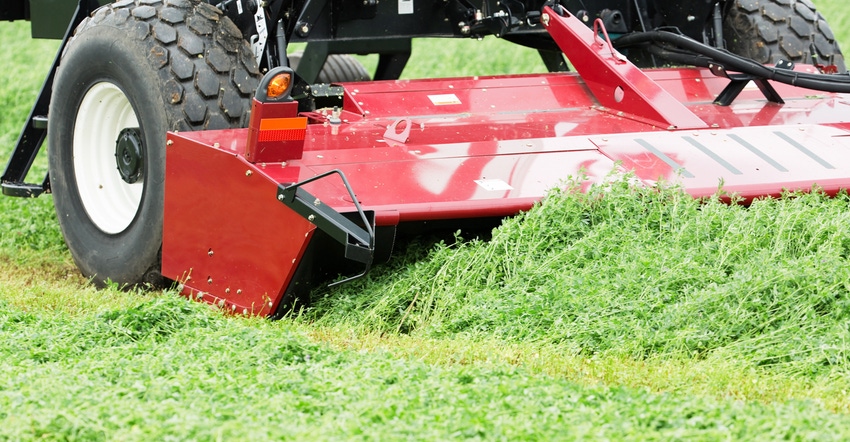April 26, 2021

Winter forage, anything that’s made into haylage — grass hay, winter forage, alfalfa, clover, anyone that you mow and dry down, it’s the same principle — has yielded more in one cutting than all five cuttings of many alfalfa harvests.
That presents both a benefit and a problem. The heavy crop comes out of the back of the mower and lands with a splat. It’s a lot of material to get to 35% dry matter.
Winter forage harvested at the flag leaf stage has highly digestible components. The fiber digestibility is higher than many brown midrib forages. I have measured sugar levels over 20% on a dry matter basis.
The nutritional quality when the mower pulls into the field compared to when it reaches the mouth of the cow can be very different. For those who are still using the traditional method of mowing directly to windrow and letting it sit for two to three days, the quality greatly decreases by the time the animal consumes it.
Mowing directly to windrow is windrow composting — it’s not preserving high-quality forage, and it’s not drying the forage as fast as it could. It’s simply aerobically composting the most readily digestible components that could be used to produce milk as it slowly overdries on the outside.
This makes a major difference in the amount of digestible energy reaching a cow’s mouth.
Many farms are instead mowing — without conditioning — directly to a swath greater than 80% of the cutter bar. Most of the leaves and intact stems dry in the sun. This allows photosynthetic drying to remove moisture faster than any machine manipulation.
Photosynthesis in sunlight converts carbon dioxide (CO2) and the plant’s water into carbohydrates. The plant, even cut off, is still alive. If the leaves are in sunlight, they continue to photosynthesize down to about 50% dry matter, removing water in the cut plant while producing sugar and other highly digestible components, and thus increasing feed quality as it simultaneously dries the forage.
This can increase the energy reaching the cow’s mouth by 20%. The key bonus is that it will dry faster than any machine handling. By not conditioning the stem, the leaves will wick the moisture out of the stem. Thus, the stem dries first and the leaves last.
Mowing without conditioning results in a swath with its leaves on top drying in the sun that maximizes photosynthesis and the stems underneath. In a narrow windrow, or if you leave it overnight, the reverse happens, and the plant respiration burns up digestible components and produces water — composting. The outside is as dry as cornflakes, and the center is as wet as direct mowed.
As the center of the windrow respires the digestible parts, it leaves no substrate for inoculants to properly ferment. Thus, Clostridia organisms take advantage of the situation, degrading the protein and producing butyric acid. These are the flat, wet, butyric smelly lumps in your silo.
Tedding is key
That said, remember that winter forage yields are 30% to 250% heavier than first-cut alfalfa. It can leave a swath that’s two to three times thicker than alfalfa. Laying the swath at greater than 80% of the cutter bar allows for photosynthetic drying, for the top couple of inches.
For a heavy crop like winter forage, the swath is thicker than the sun can penetrate. We have found that after two hours of drying, the top is getting very dry to the point that it stops drying photosynthetically, while the bottom is as wet as when you mowed it.
Tedding winter forage two hours after mowing is key to bringing up the lower layers to the sunshine for photosynthesis to dry it. Watch your tedder forward speed, though. Going too fast will make nondrying tedder lumps rather than lifting the lower layers and spreading them to dry.
The tedder must be set to the top of the stubble or else it will be rooting in the dirt, increasing ash level and decreasing milk production. Some tedders have the top tine longer than the bottom so it can move the crop without rooting in the dirt. Others have hooked teeth that do an excellent job of bringing up the bottom layers to the top.
I have seen 3-ton DM yield triticale mowed without conditioning at 80% of cutter bar width at 10 a.m., tedded at noon, and merged and chopped at 35% dry matter by 3 p.m.
Photosynthetic drying also works with other haylage crops, although they don’t usually need to be tedded. This drying results in forage that’s higher in digestible components than when the mower cut it. Old-style multiday haylage had net energy of lactation of 0.58 to 0.60. Wide swath same-day was 0.71 or more, almost the same as corn silage.
The sugar boost produced in photosynthetic drying provides substrate for the inoculant — highly recommended — to quickly drop the pH to stable silage levels, thus eliminating Clostridia and butyric formation even in wetter forages. The quick pH drop conserves even more nutrients for the cow, and the higher sugar also supports higher milk protein production.
The other result is that you only need one day to get the crop ensiled. What gets mowed today gets ensiled today. Taking smaller acreage in a one-day mow-ensile system can get more done than waiting until the crop is past prime until you get a two- or three-day window to mow the entire countryside.
In a study that we conducted on four alfalfa varieties, leaving a swath at 90% of the cutter bar width and with no conditioning, a 38-inch-tall first cutting on a humid, sunny day was ready to chop in 1.5 hours. The biggest problem is that the first year farmers try this, the silage can get too dry.
Farmers have proven that the system works.
Kilcer is a certified crop adviser in Kinderhook, N.Y.
About the Author(s)
You May Also Like




